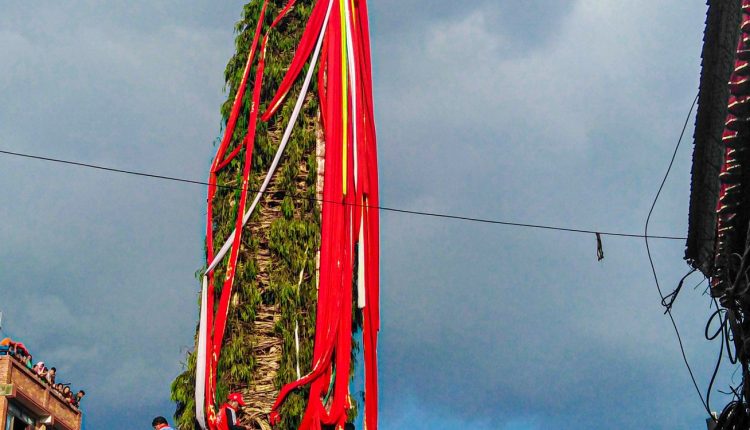Lalitpur : The festivity is back again in Nepal as Rato Machindranath, the Red God of the Himalayan nation on Friday ascended the sky-scrapping chariot which would tour around the city for months.
The chariot festival of Rato Machindranath which rolls out unto the city depends highly on astrology. The Red God locally known as “Bunga Dugh” in Newa: fraternity which means “God of Rain and Harvest” is the longest Jatra in Nepal which runs on for months.
On the first day it is taken to Ga: Bahal, then to Sundhara and then to Lagankhel after which it is taken to Iti tole and Thati tole. After the astrologers decide on an auspicious time, then the chariot is taken to Jawalakhel, and upon reaching there another festival of Bhoto Jatra is observed after four days.
Clad in red coloured jackets, dozens of members from the Newa: community spend about two weeks to prepare the sky-notching chariot which indeed is the biggest chariot that is built on an annual basis in the Himalayan Nation.
The chariot constructed annually basically uses wooden beams, and thumped adjustments to the shrine sanctum without using a single nail. It takes about two weeks for the Newa: community to build it on and is given a final touch-up with decorative before the chairing of the lord in the chariot.
Observed in the ancient town of Lalitpur, the sky-scrapping chariot goes around the city after four days of the ascension of God. After spending 4 days on the roadside constructed chariot, it is pulled to Ga:Bahal and rested for one day, after that it is pulled onto Sundhara and Mangalbazar where it is kept on for one day each.
Then after it is pulled on further to Lagankhel where it is kept on for one day. During that time, a day has been separated for women only to pull on the chariot and take it to E: thiha and then making astronomical calculations it is pulled onto Jawalakhel.
It might take more days as the priests have to look onto the auspicious times, sometimes it is holed up there for 10-15 days or even one month or more. After driving it to Jawalakhel and marking on the ‘Bhoto Jatra’ attended by the head-of-state and then the lord is taken back to Bungmati (an ancient historical town of Lalitpur) and the chariot is dismantled.
The chariot procession of Rato Machindranath always starts by end of April or early May, however, the COVID-19 pandemic pushed back the procession multiple times in earlier years.
In 2020, the area where the chariot was constructed also turned out to be a battleground as revellers tried to pull the chariot. It is believed that the chariot procession would veer off disasters, wrongdoings, and bad omens. As per the folklore, the chariot procession helps to bring on prosperity, and confidence, increase the harvest as well as bring some portion of that yielded crops to offer to the lord who as per locals provides them with the essentials.
According to the lunar calendar, the longest chariot festival in Nepal begins on the fourth day of the bright fortnight of Bachhala, the seventh month in the lunar Nepal Sambat calendar.
One of the popular legends states that once “Guru Gorkhnath” came to the city of Patan and wasn’t acknowledged by the people living there. As the commoners didn’t offer him food and ignored him, Guru Gorakhnath captured all the Serpents and held them captive under his sitting.
For being “Naags” or serpents responsible for the precipitation held captive by Guru Gorakhnath, Patan experienced drought, driving to famine in the city. Advisors of the then king of Patan Narendea Dev were asked to bring the teacher of Gorakhnath- Lord Machindranath from Assam. Hearing about the teacher’s presence in the town, Guru Gorakhnath stood up from his seat letting the serpentines loose which brought in the rain in the city ending the drought.
Adoring, Rato Machindranath Jatra for his feast, locals of Patan started a chariot procession in the city since 897 AD which is now held annually and taken around the city reminding people about his deeds.
The chariot procession of Rato Machindranath earlier was stalled due to the earthquake of 2015 which went on for nearly half a year and the COVID-19 pandemic this year also invited a similar kind of situation. However, with the ascension of Rato Machindranath on Chariot, it is expected to go ahead amid the COVID-19 scare.
There is a belief that residents of Bhaktapur can pull the chariot to their place and keep the God for six months if the procession fails to take place before Dashain-the major fortnight festival observed in Nepal during the month of October.


Comments are closed.